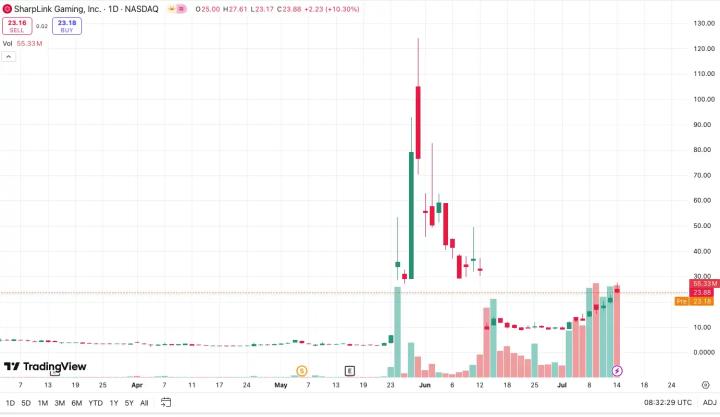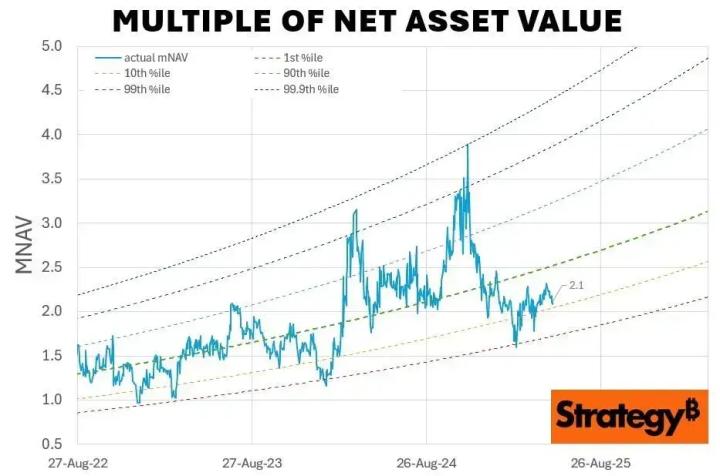Original | Odaily (@OdailyChina)
Author | Golem (@web3_golem)

On July 17, SharpLink Gaming (SBET) announced in an updated prospectus filed with the US SEC that it plans to additionally issue $5 billion in common stock on top of the original $1 billion to further purchase ETH. After the news, SBET's stock price rose to a high of $38.91 that day, but subsequently began to decline, closing at $28.98 on July 19, and opening lower on Monday with a closing price of $25.25.
This is puzzling - following the Strategy playbook, SharpLink Gaming, as the top "ETH version of Strategy", should have spiraled upward whether actually increasing ETH holdings or announcing actions favorable to ETH increase, especially when ETH continues to break through. But surprisingly, last week's SBET investors were still trapped at the peak. Has the Strategy approach lost its magic?
Market opinions generally summarize two main reasons for SBET's decline:
One is that last week, BitMine's ETH reserves (300,657 coins) briefly exceeded SharpLink, threatening its "ETH version of Strategy" title. However, on July 19, according to public information, SharpLink continued to increase ETH holdings, reaching a total of 345,158 coins, valued at over $1.2 billion, again becoming the entity with the most ETH reserves.
Two is that SharpLink Gaming's financing method combining private investment in public equity (PIPE) and at-the-market (ATM) issuance has begun to face market doubts. The additional $5 billion equity quota for SharpLink is not a price increase stimulant, but instead became a trigger for market panic.
SharpLink's Financing Method Raises Market Concerns
To understand what investors are worried about, we first need to clarify SharpLink's financing method combining PIPE and ATM. Strategy's BTC purchase funding comes from convertible bond financing, which risks debt maturity pressure and interest payments, but does not cause significant equity dilution or market selling pressure, making it a good strategy during BTC's upward phase.
However, the private equity financing (PIPE) adopted by SharpLink directly dilutes equity and creates selling pressure on stock prices. In late May, SharpLink Gaming completed a $425 million private equity investment, after which the stock price rose from a few dollars to $80. On June 12, when market rumors spread that "PIPE investors have started requesting to sell", SBET's stock price collapsed by over 70%, returning to single digits. Although SharpLink's board chairman and ConsenSys CEO Joseph Lubin later clarified that no PIPE investors actually sold, it reflected the potential fatal impact on SBET's price if selling occurs.
The $425 million financing does not support SharpLink purchasing more ETH, so it also adopted ATM stock issuance to raise funds. ATM means a listed company directly sells stocks to the secondary public market at current market prices. ATM is not completed in one go but continues until the target is reached. SharpLink's total $6 billion stock issuance may mostly be completed through this method. According to the company's SEC filings and announcements, as of July 11, SharpLink has raised $608.1 million through ATM.

SharpLink's ATM market price issuance after PIPE
After clarifying SharpLink's financing model, it's not difficult to understand market concerns. The financing method combining PIPE and ATM will cause immediate equity dilution for SEBT and bring continuous stock increment pressure. Although PIPE investors have not yet sold, they remain a potential threat to retail investors and may have been secretly selling SEBT stocks purchased at low prices while cleverly avoiding disclosure.
Moreover, ATM is essentially a legal arbitrage behavior that continuously brings selling pressure to the market. Compared to SharpLink's current market value of about $2.9 billion, the future $5 billion additional issuance seems to be draining market liquidity. The market cannot help but question whether SharpLink truly values ETH's long-term potential or is merely using it as a reusable narrative leverage.
SharpLink's ideal script might be: leverage the crypto treasury trend to accumulate ETH and boost stock prices, then directly extract investor funds through ATM to increase ETH holdings, thereby strengthening the ETH version of Strategy narrative to push stock prices up, and then sell stocks at high points in a repeated cycle. Additionally, ETH is an interest-bearing asset. According to SharpLink's latest disclosure, as of July 8, its ETH staking income reached 322 coins (approximately $1.22 million in value). This means SharpLink not only converts high-priced stocks into ETH through this left-foot-right-foot method but also enjoys capital appreciation income, ultimately leaving retail investors who chase SBET "losing both the wife and the soldiers".
BTCS Innovates TraFi + DeFi Hybrid Financing Structure
Besides SharpLink, other listed companies (such as BitMine, Bit Digital, and GameSquare) that use equity financing to reserve ETH also face equity dilution risks.
However, there is one ETH reserve listed company in the market that has not used equity financing to raise funds but instead adopted a convertible bond financing + revolving credit financing model, also known as a "TraFi + DeFi hybrid financing structure" - BTCS. As of July 21, BTCS holds 55,788 ETH, ranking 10th among listed companies.
BTCS's "TraFi + DeFi hybrid financing structure" means that on one hand, the company raises funds to purchase ETH through convertible bonds and ATM in traditional finance; on the other hand, BTCS uses ETH as collateral to borrow stablecoins in DeFi protocols like Aave to purchase more ETH.
According to official documents, as of July 21, BTCS has raised $132 million through ATM (including $28.4 million ATM sales at $7.9 per share pending settlement and $10 million convertible note funding pending completion), raised $17 million through convertible bonds, and borrowed $40 million in stablecoins through Aave (with a borrowing ratio below 40%).
BTCS currently has a market value of $144 million. Although it also uses ATM financing, the scale is not as massive as SharpLink's, causing less dilution pressure on shareholders. Moreover, BTCS does not use all ETH for pledging but further uses on-chain leverage to increase ETH holdings. If ETH continues to rise, it will create a larger revenue flywheel.
Because of ETH's inherent interest-bearing properties and mature DeFi ecosystem, unlike BTC reserve companies that can only hold BTC as digital gold in custody wallets, ETH reserve companies can use more financial tools to repeatedly monetize ETH.
However, this also raises concerns among investors: behind complex financial instruments, if all returns are based on ETH's rise, which financing model would collapse first if ETH weakens again?
ETH Version Strategy Still Undecided
Although SharpLink currently holds the most ETH and has the strongest background, the ETH version of Strategy has not yet been determined. SharpLink's left-foot-right-foot model is not built on the premise of ETH's continuous rise, but on investor trust. When investors realize that SharpLink's continuous arbitrage of stock reserves in ETH is not optimistic about ETH's long-term value, but merely a means to grow the balance sheet (ETH reserve interest does not benefit shareholders), SharpLink's narrative will go bankrupt.
BTCS's "TraFi + DeFi hybrid financing structure" controls the degree of equity dilution, but actively introducing on-chain lending also carries greater risks. If ETH's upward momentum weakens and begins to decline, BTCS will have to face risks of reduction or liquidation, which will inevitably negatively impact stock prices.
As investors gradually become clear and realize that ETH reserves are not as simple as directly purchasing BTC and storing it in a wallet, the market will no longer measure an ETH reserve listed company's value by the single standard of "ETH reserve volume". However, the current ETH reserve boom has indeed brought real buying pressure and capital speculation to ETH, therefore, instead of cross-border speculation in crypto stocks, directly purchasing or going long on ETH is what we "noble crypto investors" should do.







